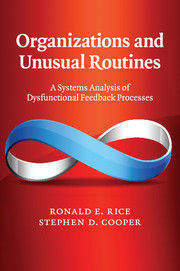Book contents
- Frontmatter
- Contents
- List of figures
- List of tables
- List of boxes
- Preface
- Acknowledgments
- 1 Crazy systems, Kafka circuits, and unusual routines
- 2 Causes, symptoms, and subroutines of unusual routines in six computer information/communication systems
- 3 Getting personal: unusual routines at the customer service interface
- 4 A multi-theoretical foundation for understanding unusual routines
- 5 A detailed case study of unusual routines
- 6 Summary and discussion of the case study results
- 7 Individual and organizational challenges to feedback
- 8 A multi-level and cross-disciplinary summary of concepts related to unusual routines
- 9 Recommendations for resolving and mitigating unusual routines and related phenomena
- 10 Summary and a tentative integrated model of unusual routines
- References
- Index
3 - Getting personal: unusual routines at the customer service interface
Published online by Cambridge University Press: 10 January 2011
- Frontmatter
- Contents
- List of figures
- List of tables
- List of boxes
- Preface
- Acknowledgments
- 1 Crazy systems, Kafka circuits, and unusual routines
- 2 Causes, symptoms, and subroutines of unusual routines in six computer information/communication systems
- 3 Getting personal: unusual routines at the customer service interface
- 4 A multi-theoretical foundation for understanding unusual routines
- 5 A detailed case study of unusual routines
- 6 Summary and discussion of the case study results
- 7 Individual and organizational challenges to feedback
- 8 A multi-level and cross-disciplinary summary of concepts related to unusual routines
- 9 Recommendations for resolving and mitigating unusual routines and related phenomena
- 10 Summary and a tentative integrated model of unusual routines
- References
- Index
Summary
Perhaps the most familiar unusual routine is the combination of a customer's experience with and then complaint about some unsatisfactory interaction with an organization, its service, or its product, and the organization's lack of, insufficient, or mismatched response. The main assumption behind this claim is that most customers are not asking for any particularly exceptional or unusual service, product, or information; they are simply following the standard, normal, or explicit procedures associated with an advertisement, offer, instruction, standard retail clerk interaction, attempt to use the product or service, or inquiry. Despite this, they experience difficulties or problems with one or more of these, suggesting that others – possibly everyone – also following the procedures will experience the problem as well. When they attempt to communicate with the organization to gain an understanding of the situation, resolve it, return the product, get a refund, possibly institute legal action, or simply to convey their feelings the effort involves a variety of work, delay, error, and blame (as well as straightforward financial cost) subroutines, along with general frustration. And it may not result in a favorable response, or, for that matter, any response at all. So there are two levels of problems here: the original UR experience, and the UR experience in trying to communicate about the original experience.
- Type
- Chapter
- Information
- Organizations and Unusual RoutinesA Systems Analysis of Dysfunctional Feedback Processes, pp. 67 - 106Publisher: Cambridge University PressPrint publication year: 2010



